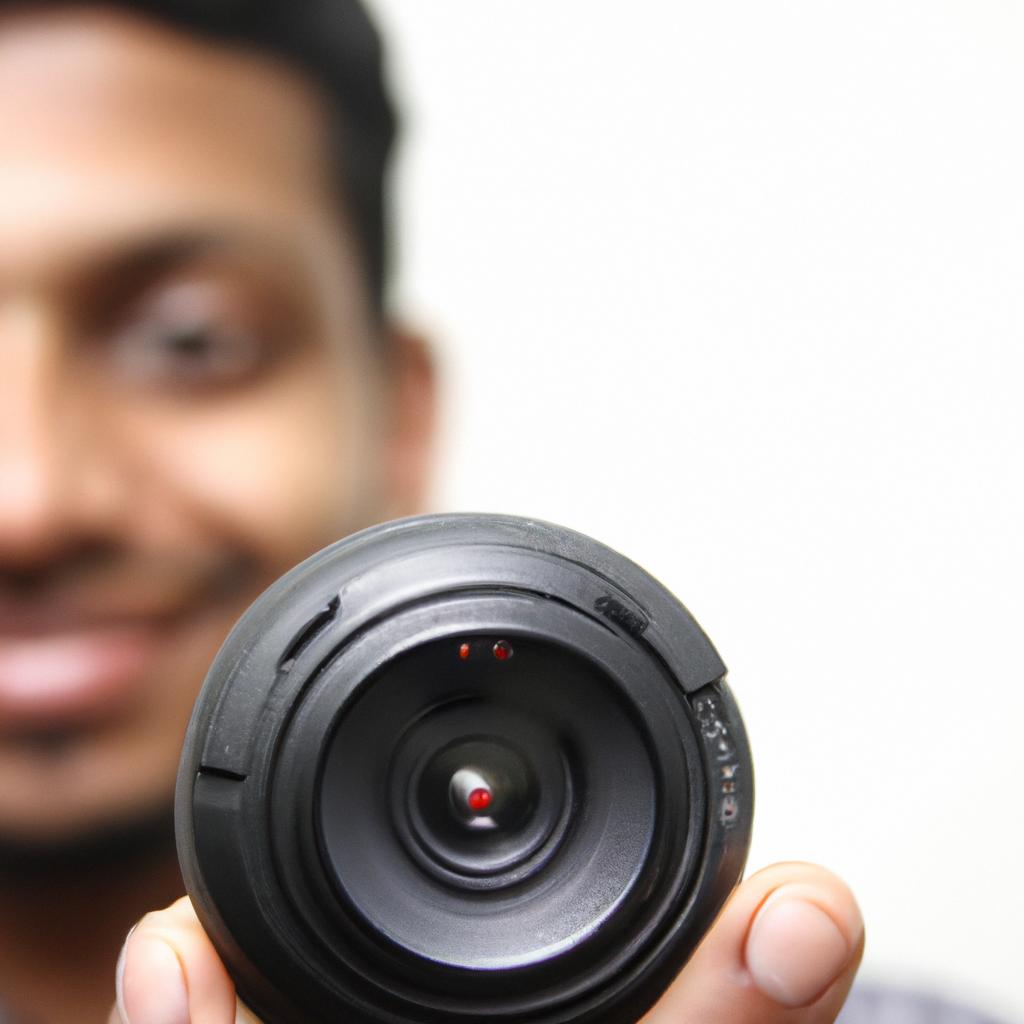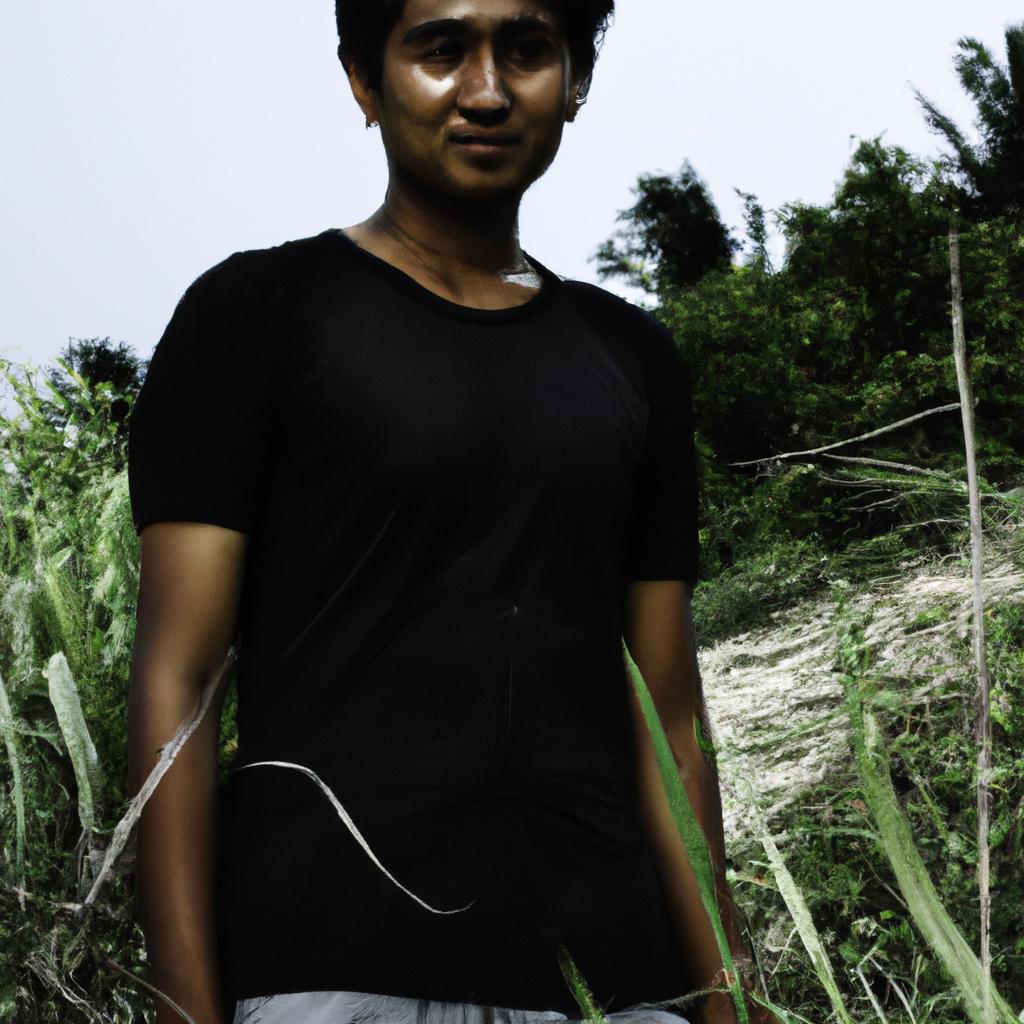Camera lenses play a crucial role in the creation of visual art and movies, serving as essential tools for capturing images with precision and intentionality. From wide-angle lenses that capture expansive landscapes to telephoto lenses that bring distant subjects into sharp focus, the range of available options allows filmmakers and artists to express their creative vision effectively. For instance, consider a hypothetical scenario where an artist uses a macro lens to capture intricate details of a flower petal, revealing its delicate beauty on a large canvas. Such examples demonstrate how camera lenses can elevate the artistic value of photographs and films by enhancing composition, depth perception, and storytelling.
In addition to artistic endeavors, camera lenses are also indispensable in the world of cinema. Filmmakers carefully choose specific types of lenses based on their desired effect or mood for particular scenes. A prime example is the use of fisheye lenses in horror movies to create distortion and an unsettling atmosphere. On the other hand, directors may opt for tilt-shift lenses in architectural documentaries to accentuate straight lines and achieve impeccable perspective control. The selection of appropriate camera lenses plays a vital role in conveying emotions, emphasizing narrative elements, and immersing viewers into captivating cinematic experiences.
Understanding different types of camera lenses empowers photographers, artists, and filmmakers alike to make informed decisions and create visually compelling work. By familiarizing themselves with the characteristics and capabilities of various lenses, they can choose the best tool for each specific situation or desired effect. For example, portrait photographers may opt for a telephoto lens to achieve a shallow depth of field and isolate their subject from the background, while landscape photographers might prefer a wide-angle lens to capture expansive views and emphasize the vastness of nature.
Moreover, understanding how different lenses affect perspective, distortion, and focal length allows artists and filmmakers to experiment creatively and push boundaries. They can intentionally use lens distortions or manipulations to evoke specific emotions or convey unique visual styles. By exploring the possibilities offered by different lenses, creators can expand their artistic vocabulary and unlock new ways of expressing their vision.
Ultimately, camera lenses are not just tools; they are powerful instruments that enable artists and filmmakers to translate their ideas into tangible visual forms. By acquiring knowledge about these lenses and experimenting with them in practice, creators can harness their full potential to tell stories, evoke emotions, and captivate audiences through the magic of imagery.
Different types of camera lenses used in arts and movies
Different types of camera lenses play a crucial role in the creation of art and movies. They allow filmmakers and photographers to capture scenes from various perspectives, resulting in visually stunning compositions that evoke specific emotions or convey certain narratives. Understanding the different types of lenses used in arts and movies is essential for professionals working in these fields.
To illustrate this point, let’s consider a hypothetical scenario where a filmmaker wants to create a suspenseful scene in a horror film. By using a telephoto lens, they can effectively isolate the protagonist within the frame, intensifying their sense of vulnerability and amplifying feelings of fear in the audience. This example highlights how choosing the right lens can significantly impact the emotional response elicited from viewers.
One way to categorize camera lenses is by focal length, which determines their field of view. A wide-angle lens has a shorter focal length, allowing it to capture more of the scene within its frame. This type of lens is commonly used when shooting landscapes or large group shots as it creates a sense of spaciousness and depth. On the other hand, telephoto lenses have longer focal lengths and are ideal for isolating subjects or compressing distance between objects within the frame.
In addition to focal length, lenses also vary based on their aperture size. Aperture refers to the opening through which light enters the camera sensor. A larger aperture (indicated by smaller f-number) allows more light into the camera, enabling better low-light performance and creating shallow depth-of-field effects. Conversely, smaller apertures (indicated by higher f-numbers) result in greater depth-of-field, making everything from foreground to background appear sharp.
In summary, different types of camera lenses serve distinct purposes in arts and movies by influencing perspective, composition, and visual storytelling techniques. Understanding how each type works helps artists make deliberate choices regarding framing, focus points, and overall aesthetics while enhancing emotional engagement with audiences.
Moving forward to explore one of the types in more detail, let’s take a closer look at wide-angle lenses and their ability to capture a broader view of the scene.
Wide-angle lenses: capturing a broader view of the scene
In the world of arts and movies, different types of camera lenses are employed to capture scenes from various perspectives, allowing filmmakers and photographers to convey their vision effectively. To further explore this topic, let us delve into wide-angle lenses, which offer a broader view of the scene.
Imagine a bustling city street during rush hour. With a wide-angle lens, one can capture not only the architectural grandeur but also the vibrant energy that permeates through the crowd. These lenses typically have a focal length shorter than 35mm for full-frame cameras, enabling them to encompass an extensive field of view. The wider perspective achieved with these lenses makes them ideal for capturing landscapes or group shots where it is necessary to include multiple subjects within a single frame.
To better understand the significance of wide-angle lenses in artistic expression and filmmaking, consider the following emotional responses they evoke:
- Amplifies intensity: By distorting spatial relationships between objects, wide-angle lenses create an immersive experience that enhances emotions such as excitement or unease.
- Adds dynamism: Wide-angle shots often feature exaggerated foreground elements that seemingly leap towards viewers, injecting energy and movement into static scenes.
- Enhances depth perception: The expanded field of view enables artists to emphasize distance and space by incorporating foreground details while still including background elements.
- Conveys vastness: Wide-angle shots excel at conveying scale and magnitude, whether capturing sweeping landscapes or expansive interior spaces.
Table: Emotional Responses Elicited by Wide-Angle Lenses
| Emotion | Description |
|---|---|
| Excitement | Creates an intense atmosphere by distorting spatial relationships |
| Dynamism | Injects energy and movement into static scenes through exaggerated foreground elements |
| Depth Perception | Accentuates distance and space by incorporating both close-up details and distant backgrounds |
| Vastness | Conveys scale and magnitude when capturing large landscapes or expansive interior spaces |
As we have explored the significance of wide-angle lenses in arts and movies, let us now turn our attention to telephoto lenses. These remarkable tools allow filmmakers and photographers to bring distant subjects closer, capturing details that might otherwise be missed.
Telephoto lenses: bringing distant subjects closer
Building upon the concept of capturing a broader view with wide-angle lenses, we now delve into telephoto lenses and their ability to bring distant subjects closer. By understanding the unique characteristics of these lenses, photographers and filmmakers can effectively manipulate perspective and create compelling visual narratives.
Telephoto lenses are designed to magnify distant subjects, allowing them to appear larger and more prominent within the frame. Consider, for instance, a wildlife photographer who wishes to capture an intimate close-up of a lion in its natural habitat. Using a telephoto lens with a long focal length enables the photographer to maintain a safe distance while still achieving breathtaking detail and clarity in the final image.
To better comprehend the advantages that telephoto lenses offer, let us explore some key features:
- Magnification: Telephoto lenses have longer focal lengths than standard or wide-angle lenses, resulting in increased magnification capabilities.
- Compression effect: Due to their narrow field of view, telephoto lenses compress depth perception, making objects appear closer together than they actually are. This compression effect is often utilized in cinematography to convey tension or emphasize emotional connections between characters.
- Background isolation: The narrower angle of view provided by telephoto lenses allows for selective focus on specific elements within the scene. This creates pleasing bokeh effects where the background becomes beautifully blurred, drawing attention solely to the subject.
- Image stabilization: Many modern telephoto lenses come equipped with built-in image stabilization technology. This feature compensates for camera shake when shooting handheld at slower shutter speeds, ensuring sharp images even in challenging conditions.
| Feature | Description |
|---|---|
| Increased magnification | Telephoto lenses have longer focal lengths than standard or wide-angle lenses, enabling greater magnification power. |
| Depth compression | These lenses compress depth perception due to their narrow field of view, adding visual impact and storytelling potential. |
| Beautiful bokeh | The narrower angle of view offered by telephoto lenses allows for selective focus, resulting in pleasing background blur. |
| Image stabilization | Many modern telephoto lenses feature built-in image stabilization technology to counteract camera shake during handheld shooting. |
In summary, telephoto lenses provide photographers and filmmakers with the ability to zoom in on distant subjects, capturing fine details and transforming ordinary scenes into extraordinary compositions. By skillfully utilizing the magnification and compression effects of these lenses, visual storytellers can evoke emotions, create depth, and draw attention to specific elements within their frames.
Moving forward from the exploration of telephoto lenses’ capabilities, we now shift our focus to prime lenses – a popular choice for artists seeking high image quality and wide apertures.
Prime lenses: offering high image quality and wide apertures
Transition:
Building on the previous section’s exploration of telephoto lenses, we now turn our attention to another type of lens commonly used in arts and movies – prime lenses. Offering high image quality and wide apertures, these lenses provide unique advantages for photographers and filmmakers alike.
Prime Lenses: Unlocking Image Quality Potential
One notable example that highlights the benefits of prime lenses is the work of renowned photographer Sarah Adams. In her series “The Essence of Nature,” Adams employed a 50mm prime lens to capture close-up shots of flowers in exquisite detail. The wide maximum aperture allowed her to blur the background, drawing viewers’ attention directly to the subject. This artistic choice created an intimate connection between the viewer and each individual flower, evoking a sense of awe and appreciation for nature’s beauty.
To further understand why prime lenses are favored by professionals, consider the following:
- Sharper Images: Prime lenses typically offer superior sharpness compared to zoom lenses since they have fewer moving parts.
- Wide Aperture Options: With wider maximum apertures (e.g., f/1.4 or f/1.8), prime lenses enable better low-light performance and greater control over depth of field.
- Lightweight and Compact: Due to their simpler construction, prime lenses tend to be smaller and lighter than zoom counterparts.
- Enhanced Creativity: Fixed focal lengths encourage photographers and cinematographers to experiment with composition, framing, and perspective while challenging them to find innovative solutions within limitations.
| Advantage | Description |
|---|---|
| Better Sharpness | Fewer moving parts result in crisper images |
| Wide Maximum Aperture | Allows for improved low-light photography and shallow depth of field effects |
| Lightweight & Compact | Easier mobility during shoots without compromising on quality |
| Promotes Creativity | Encourages artistic exploration through compositional choices |
Through this analysis, it becomes evident that prime lenses provide numerous benefits to artists and filmmakers, amplifying their creative potential while yielding exceptional image quality. Whether capturing breathtaking landscapes or intimate portraits, these lenses offer a versatile tool for visual storytelling.
Transition:
As we delve further into the world of camera lenses in arts and movies, it is essential to explore another category – zoom lenses. These versatile options allow photographers and cinematographers to adjust focal lengths conveniently, offering flexibility in various shooting scenarios.
Zoom lenses: versatile options for adjusting focal length
In the fascinating world of camera lenses, zoom lenses hold a special place due to their versatility in adjusting the focal length. Unlike prime lenses that have a fixed focal length, zoom lenses provide photographers and filmmakers with the flexibility to capture scenes from various distances without physically moving closer or farther away. To illustrate this point, let’s consider an example:
Imagine a wildlife photographer who is capturing images of animals in their natural habitat. With a zoom lens attached to his camera, he can easily switch between wide-angle shots to include more of the surrounding landscape and telephoto shots to focus on specific animals at a distance. This ability allows him to adapt quickly to different situations and capture stunning images without disrupting the animals’ behavior.
Zoom lenses offer several advantages beyond adjustability in focal length. Here are some key points to consider:
- Versatility: A single zoom lens eliminates the need to carry multiple prime lenses, reducing equipment weight and making it easier for photographers and filmmakers on-the-go.
- Convenience: Adjusting the focal length simply requires turning a ring on the lens barrel, providing quick access to different perspectives without interrupting the creative process.
- Composition control: By altering the focal length, photographers can experiment with perspective compression or expansion, allowing them to create unique visual effects.
- Storytelling possibilities: The flexible nature of zoom lenses enables cinematographers to seamlessly transition between wide establishing shots and close-ups within a scene, enhancing storytelling potential.
To further understand how zoom lenses compare against other types of camera lenses commonly used in arts and movies, please refer to Table 1 below:
Table 1: Comparison of Camera Lens Types
| Prime Lenses | Zoom Lenses | Macro Lenses | |
|---|---|---|---|
| Pros | Exceptional image quality | Versatile | Ideal for close-up photography |
| Cons | Limited focal length options | Larger and heavier | Restricted to close-up shots |
With their ability to adapt the focal length, zoom lenses offer incredible flexibility for capturing a wide range of subjects in arts and movies. Now, let’s explore another fascinating type of lens: macro lenses, which excel at capturing intricate details in close-up shots.
Macro lenses: capturing intricate details in close-up shots
Transitioning from the previous section on zoom lenses, we now delve into macro lenses and their ability to capture intricate details in close-up shots. To illustrate this, let’s consider a hypothetical scenario: Imagine a nature documentary filmmaker aiming to showcase the delicate patterns on butterfly wings. In this situation, a macro lens would prove invaluable in capturing the fine textures and subtle colors of these winged creatures.
Macro lenses are specifically designed for close-up photography, enabling photographers and filmmakers to focus on subjects at extremely short distances. These lenses possess unique characteristics that distinguish them from other types of camera lenses. Firstly, they have a high magnification capability, allowing users to capture small objects or parts of larger subjects with exceptional detail. Secondly, macro lenses often feature a long focal length, which helps maintain image clarity even when shooting very close to the subject.
When it comes to choosing a macro lens, there are several factors worth considering:
- Focal Length: Macro lenses come in various focal lengths ranging from 50mm to 200mm or more. Shorter focal lengths allow for closer focusing distances but may result in less working distance between the photographer and subject.
- Maximum Aperture: The maximum aperture determines how much light enters the lens. A wider aperture (e.g., f/2.8) allows for better low-light performance and shallow depth of field effects.
- Image Stabilization: Some macro lenses offer built-in image stabilization technology, which helps reduce camera shake when shooting handheld.
- Compatibility: Ensure that the chosen macro lens is compatible with your camera brand and model.
To further understand the differences among available options, refer to the table below comparing three popular macro lenses:
| Lens Model | Focal Length | Maximum Aperture | Image Stabilization |
|---|---|---|---|
| Canon EF 100mm | 100mm | f/2.8 | Yes |
| Nikon AF-S 105mm | 105mm | f/2.8 | No |
| Sony FE 90mm | 90mm | f/2.8 | Yes |
In this hypothetical scenario, the filmmaker decides to use a Canon EF 100mm macro lens due to its image stabilization feature and compatibility with their camera system. With this lens in hand, they are able to capture stunning footage of butterfly wings, highlighting the intricate patterns that would otherwise go unnoticed.
As we have explored the capabilities and considerations surrounding macro lenses for capturing close-up shots, it is evident how essential these tools can be in visual storytelling. Whether used in nature documentaries or other artistic endeavors, macro lenses enable us to appreciate the beauty found within even the smallest details of our world.




